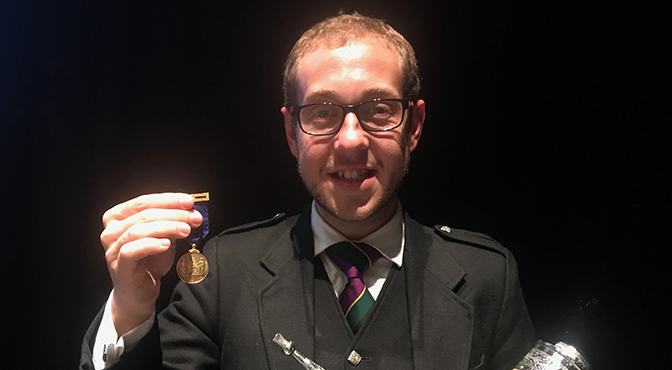
Some Personal Reflections on
Oban and Inverness
By Chris Terry, South Africa
Archibald Campbell of Kilberry spent a number of years in India, and on his return was able to document changes that he observed in the playing of the pipers of the day. These were probably almost unnoticed by the pipers themselves, as these changes would have been gradual and evolutionary; but for someone who had been away for a sustained period, the changes were quite significant.
It is now 23 years since I last competed at Oban and Inverness, and, although I have attended both contests once in the intervening years, I have noticed some relatively minor changes in the evolution, and one or two quite significant ones. I heard almost the entire Gold Medal at the Argyllshire Gathering (I missed the last two), and at the Northern Meeting (where I missed the first two), and all but the first in the Clasp.
Probably the most noticeable is that the quality of the instruments has reached a very high level. I noted with interest Ian McLellan’s comments about the balance, particularly the lack of bass sound. My comment really revolves around the fact that hardly an instrument was less than perfect in tuning, with balanced note intervals, and hardly any drifted noticeably off the mark during the performance. This made listening to the music a pleasure throughout.
Secondly, the standard of technique was amazing – such that the odd slightly second-rate crunluath or taorluath seemed to be the sheep and goat separator. Miss one gracenote (approximately 30 milliseconds in a 14 minute performance), and you are dead in the water. A note error seems to be less of an issue these days (and rightly, perhaps) than it used to be, but don’t miss a B gracenote in a D taorluath!
[wds id=”2″]
On the subject of technique though, I felt that there is a tendency to play some of the heavier movements (darodo, throws from low G to high G, and particularly the throw to F) so quickly that they are almost non-existent. They are there for a purpose – otherwise the composer would probably have used just a plain gracenote. Clear but crisp is what is desired.
Another area of change is that of tempo. There seems to be less variation within the tune (singling to doubling, for example) than was the case; and generally the tunes are taken more quickly than they used to be, particularly laments – though the path between ‘stately and dignified’ and ‘dragged’ is a fairly narrow one to tread. And some of the bolder, more aggressive tunes seem to be treated less boldly than in the past.
It was in the area of musicality that I have to admit to some disappointment. When I was fortunate enough to spend a little over a year of weekly lessons with the late John MacFadyen in 1975, he placed great emphasis on phrasing, particularly holding the ends of the phrases, tempo contrasts, rhythm, and the smooth transition from one variation to the next. What appears to be the norm now is a somewhat sterile, bland, ‘play it safe’ approach.
It is understandable that the players tend to play cautiously (there is much at stake, after all), but the sad thing is that judges seem to award the prizes more often to those who play cautiously (and correctly) on good instruments, with good technique, and less often to those who play real music, and try to get the music out of the tune.
Free of this criticism, I felt, were John-Angus Smith, and Connor Sinclair, at Inverness. John-Angus’s Nameless, hiharin dro o dro was the seventh that I heard in the two Gold Medal contests, and his performance really popped out, for me – good phrasing, good control, good tempo contrasts – my winning tune! This is not a tune I particularly care for, but he made it speak to me. Perhaps his pipe, with a rather robust drone sound, was not to the judges’ liking.
I also liked Connor Sinclair’s tune, Lady MacDonald’s Lament, which had great phrasing and tempo control, but was a little inconsistent in timing in places (for example the repeat of Line 1 in the ground was timed very slightly differently). His transition to the cadences was not quite consistent, though I applaud what he was trying to do – but with added maturity he will achieve greater consistency. Faye Henderson showed why she regularly finds her way into the major prizes with her rendering of the Park Piobaireachd No2 which had subtlety and control, but a couple of suspect D taorluaths must have knocked her out of the reckoning.
The Clasp was a wonderful experience, with some of the bigger tunes set, though even some of the top players seemed guilty of aspects of my criticisms above. It was a pity that the two slightly less frequently heard tunes, Craigellachie and My Dearest on Earth, Give Me Your Kiss, received only one hearing each. (I also heard only one performance of the Vaunting in the two Gold Medal contests, but it is certainly possible I missed another. It wasn’t submitted all that often.)
Two general points might be of interest. I like the system at Inverness where the tunes submitted are all displayed on the screen. It would be good to see this practice followed at Oban too. (In the past these were sometimes given in the programme. While space might be an issue there, a simple numbering system could be used to save printing the names multiple times.)
It would also be useful with this display to indicate if a setting other than PS or Kilberry is being offered. Lord Lovat’s Lament was a case in point, where several competitors played a setting that was not the Kilberry or PS setting, nor Angus MacKay, but they all played the same setting, so what I originally thought was an error (or in fact several errors) appeared to be acceptable.
The standard is extremely high; one after another the players display a high level of skill on beautifully tuned instruments. Add to this the pleasure of seeing a number of old friends, and you have the recipe for a great few days in Scotland. And the weather was kind too!
[wds id=”3″]
